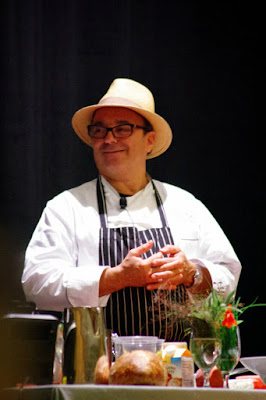Seattle - the land of coffee, great restaurants, Pike Place
Market and the International Food Blogger Conference. I spent the weekend
soaking up all IFBC2014 had to offer.
What exactly did they offer you ask? Well, let me
tell you:
· A chance to meet other fabulous food bloggers,
· Exposure to new products and companies
· Attend educational, informative and often once
in lifetime sessions with renowned authors, CEOs, photographers, writers, chefs
and industry experts
· Delicious food
· Exploration of a vibrant, friendly city
· Swag – and lots of it.
Today, I’m going to share a few things I learned from my
favorite sessions. And trust me it’s just a few tidbits from three of many
sessions – I have a notebook full of scribbles from each one!
Photography with Todd Coleman
 Todd is Creative Director of Tasting Table. He offered great photography tips that I am hoping to incorporate into my
photography. A few of his tips include:
Todd is Creative Director of Tasting Table. He offered great photography tips that I am hoping to incorporate into my
photography. A few of his tips include:
“Do something unexpected.” – Todd Coleman
 Cooking demo with Theirry Rautureau aka The Chef in the Hat
Cooking demo with Theirry Rautureau aka The Chef in the Hat
I hadn’t heard of Chef Theirry before IFBC but this
Frenchman in Seattle has a long history in the Emerald city. I hear he is much like Chef Vij in Vancouver in that he
loves to mingle with his restaurant guests and will even sit down for a story
or two.
At his IFBC cooking demonstration he showed us a simple
tomato soup that could be served warm or cold. As he cooked he shared some
great tidbits and his endearing humour. Here are a few of the things I took
away with me:
- If you have olive oil but don’t use it all the time, you should refrigerate it so it doesn’t go rancid.
- You can pickle almost anything! He suggested pickling celery sticks! Just remember the magic ratio 3:2:1. 3 parts vinegar; 2 parts water; 1 part sugar – bring the mixture to a boil and then cool it. Once cooled, poor it over celery sticks, radishes, beets, and almost any root veggies is up for grabs! You can also add a cinnamon stick or other spice if you like. Chef Theirry said you can even pickle apples and rhubarb!
- To dress a salad with your favorite dressing pour it on the sides of a high bowl and THEN add your lettuce and toppings. Gently mix your greens. Your dressing will be evenly dressed!
Know your Beef, Know your Butchery: Cut Education Session
 I think I learned the most at this fact filled sessions put on by Beef Checkoff.
Here are just a few tidbits.
I think I learned the most at this fact filled sessions put on by Beef Checkoff.
Here are just a few tidbits.- Tenderness
- Juiciness
- Taste/flavor
- Marbling also acts as a bit of insurance when it comes to overcooking! If it has a high marbling percentage it will still taste great even if you over cook it a bit
- smallest herd since the 1950s because of drought
- things are starting to rebound but takes time
- Want to save money? Go for less tender cuts like chuck, brisket, loin. These cuts are close to the animals limbs which means they are subject to lots of motion and thus less connective tissue. This makes them less tender. But that doesn't mean they can’t make great meals! You just have to know how to coax out their best flavour and taste. So when you cook these cuts think braising, long and slow cooking, adding moisture.
- All beef starts on grass but are finished for their last 100-200 days on either grass or grain (which also includes some grass)
- Only 2-3% of the US herd is bred for sale as prime beef.

My next post IFBC2014 will be about my favorite session: The Sur la Table/Kitchen Aid excursion and my favorite food finds from the conference!
Note: In order to receive the discounted active blogger rate at IFBC2014, all participating bloggers were required to write three posts about their experience at the conference. This is post #2.
Note: In order to receive the discounted active blogger rate at IFBC2014, all participating bloggers were required to write three posts about their experience at the conference. This is post #2.

No comments:
Post a Comment